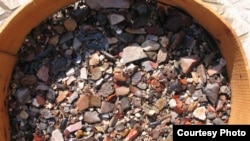New research shows that early agriculture sprang up in the eastern Fertile Crescent, in modern day Iran, at roughly the same time as it did in areas of the region -- in what are now Israel, Syria, Turkey and Iraq.
Researchers from Germany’s University of Tubingen led the excavations in the foothills of the Zagros Mountains in northern Iran from 2009 to 2010. What they found was evidence of early agriculture dating back to the end of the last Ice Age, about 12,000 years ago.
“There is not just one village where you can say, ‘This is where domestication occurred,’” according to Nicholas Conrad, head of the archaeological team that made the new discoveries who spoke to Discovery.com. “It wasn’t as if the development of agriculture was like someone flipped a light in one place and from that point of origin, agriculture spread. It’s a process that occurred in a whole range of places.”
At the site, known as Chogha Golan, archeologists unearthed architectural remains, stone tools, depictions of humans and animals, bone tools, animal bones, and – perhaps most importantly – the richest deposits of charred plant remains ever recovered from the pre-pottery Stone Age of the Near East.
According to the researchers, Chogha Golan was a particularly rich location because it had been occupied for a long time. Most pre-pottery Neolithic sites were usually not inhabited for a long period.
The picture painted by what was found sheds light on early farming. The most numerous crop species from Chogha Golan are wild barley, goat-grass and lentils, which are all ancestors of modern crops.
The record of plant remains over a long period of time portrays a fundamental shift in how humans lived, moving from hunter-gatherers to the use of domesticated species. This shift formed the economic basis of village life and subsequent civilization.
Researchers from Germany’s University of Tubingen led the excavations in the foothills of the Zagros Mountains in northern Iran from 2009 to 2010. What they found was evidence of early agriculture dating back to the end of the last Ice Age, about 12,000 years ago.
“There is not just one village where you can say, ‘This is where domestication occurred,’” according to Nicholas Conrad, head of the archaeological team that made the new discoveries who spoke to Discovery.com. “It wasn’t as if the development of agriculture was like someone flipped a light in one place and from that point of origin, agriculture spread. It’s a process that occurred in a whole range of places.”
At the site, known as Chogha Golan, archeologists unearthed architectural remains, stone tools, depictions of humans and animals, bone tools, animal bones, and – perhaps most importantly – the richest deposits of charred plant remains ever recovered from the pre-pottery Stone Age of the Near East.
According to the researchers, Chogha Golan was a particularly rich location because it had been occupied for a long time. Most pre-pottery Neolithic sites were usually not inhabited for a long period.
The picture painted by what was found sheds light on early farming. The most numerous crop species from Chogha Golan are wild barley, goat-grass and lentils, which are all ancestors of modern crops.
The record of plant remains over a long period of time portrays a fundamental shift in how humans lived, moving from hunter-gatherers to the use of domesticated species. This shift formed the economic basis of village life and subsequent civilization.












